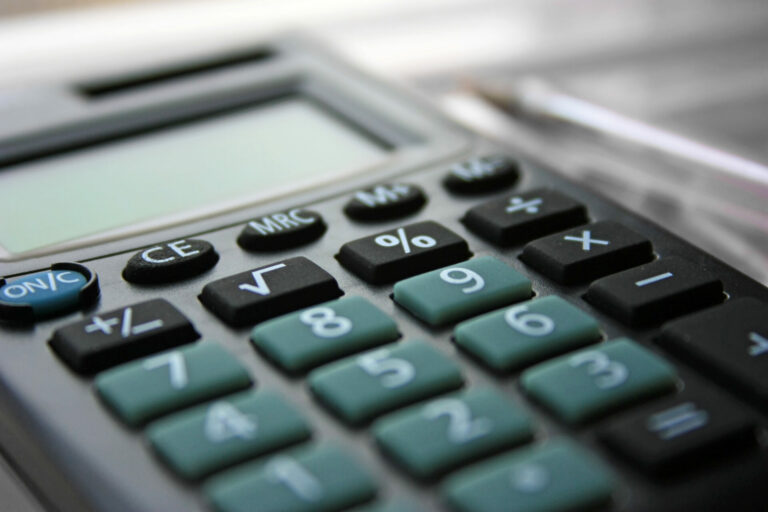GCSE Maths exams are coming up (20 May, 7 June and 13 June), and if you want to do well on them, you need to start revision now. In this article, we will outline the basics of GCSE Geometry as covered by the curriculum.
This includes topics such as Construction, Bearings, Loci, Angles, Angles Theorems, properties of Polygons, Quadrilaterals, Transformations, Circles and properties of 3D Shapes.
Finally, we will give a brief overview of a GCSE Maths exam itself, covering which topic should appear on each paper.
Introducing GCSE Geometry
Geometry is a branch of mathematics that deals with the properties and measurements of shapes. It covers topics such as constructions, bearings, loci, angles, and angles theorems. As well as properties of polygons, quadrilaterals, transformations, circle theorem, definitions, properties of 3D shapes, area, perimeter, and volume.
Geometry can be challenging but it is a very important subject to master. The skills you learn in GCSE Geometry can be applied to many real-world situations. For example, if you understand how to calculate the area of a shape, you can work out the size of a room. And the amount of paint you need for the job.
The basic Geometry covered in the GCSE Maths curriculum
The curriculum content for GCSE Geometry includes topics such as Construction, Bearings, Loci, Angles, properties of Polygons, Quadrilaterals, Transformations, Circles, properties of 3D Shapes, Area, Perimeter and Volume.
You will need to know how to use a protractor and a ruler to complete some of the questions in the exam. It is important to practice using these tools before the exam so that you feel confident using them on the day.
We will cover each of these topics more in depth below.
Constructions
Construction is a geometric figure that is created by drawing lines or curves on a piece of paper. You can use a ruler and protractor to help you make accurate constructions. There are several construction techniques that you need to know for the GCSE Maths exam. These include:
- Point-to-point Construction: This requires you to draw a line between two points.
- Perpendicular Construction: This requires you draw a line that is perpendicular to another line.
- Parallel Construction: Where you draw a line that is parallel to another line.
- Bisecting an Angle: This is when you divide an angle into two equal parts.
It is important to practice these construction techniques, so that you are confident and proficient with their use come the day of the examination.
Example GCSE geometry Question:
On the grid, draw a parallelogram.
Model Answer:
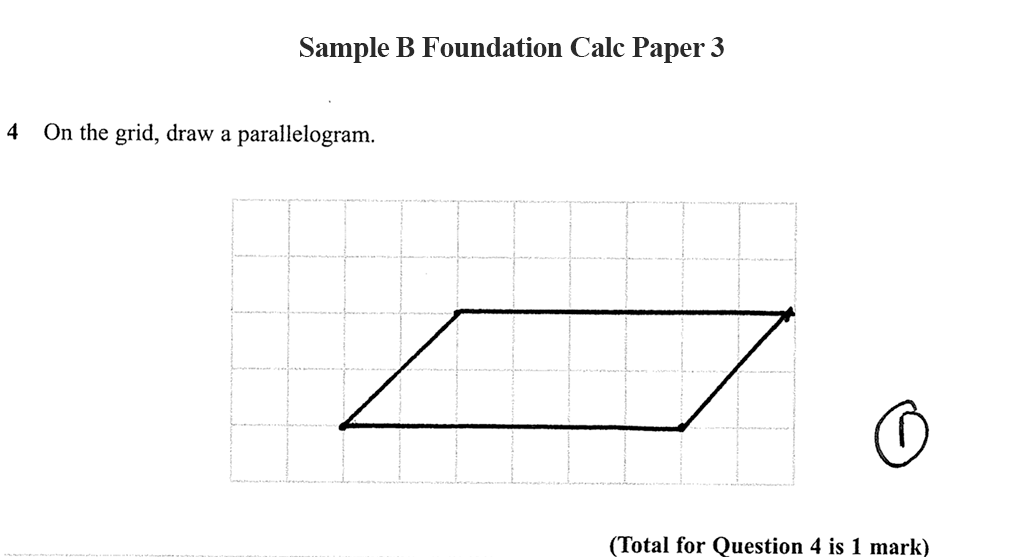
Bearings
Bearings are three figure angles measured clockwise from North. There is a set of rules how bearings should be calculated:
- You should always measure bearings from North.
- You should Express bearings as three-figure bearings (so 90° would be 090°).
- You should always draw and measure bearings clockwise.
For more information about bearings, find the article here.
Loci
A Locus is a set of points that satisfies a certain condition. For example, the locus of points that are 10cm from a given point is a circle with a radius of 10cm.
There are two types of loci that you need to know for the GCSE Maths exam:
- Circles: A circle is the locus of points that are a given distance from a given point (the centre).
- Straight lines: A straight line is the locus of points that are equidistant from two given points.
Loci can be used to solve problems in GCSE geometry. For example, if you know the locus of points that are 10cm from a given point, you can use this to find the diameter of a circle.
Example GCSE geometry Question:
A,B and C are three points on a map.
1 cm represents 100 metres.
Point T is 250 metres from point A.
Point T is equidistant from point B and point C.
On the map, show one of the possible positions for point T.
Model Answer:

Angles
An Angle forms when two lines meet. The angle is the amount of rotation needed to move one line so that it is parallel to the other line. We measure angles in degrees.
There are several types of angles that you need to know for the GCSE Maths exam:
- Right angles: These are angles that measure exactly 90 degrees.
- Acute angles: These are angles that measure less than 90 degrees.
- Obtuse angles: These are angles that measure more than 90 degrees.
- Straight angles: These are angles that measure exactly 180 degrees.
Angles are measured using a protractor. It is important to practise using a protractor before your exam so that you feel confident using it on the day.
For more information about angle facts, find the article here.
Angle Theorems
There are several angle theorems that you need to know for the GCSE Geometry part of the exam. These include:
- The angle at the centre of a circle is double the size of the angle at the circumference.
- The three angles of a triangle add up to 180 degrees.
- The angles around a point add up to 360 degrees.
- The angles in a parallelogram add up to 360 degrees, but also have a matching pair of angels at the ends of the diagonals.
These theorems can be used to solve GCSE Geometry problems. For example, if you know that the angles in a triangle add up to 180 degrees, you can use this to find the size of an angle if you know the sizes of the other two angles.
Example Angle Question:
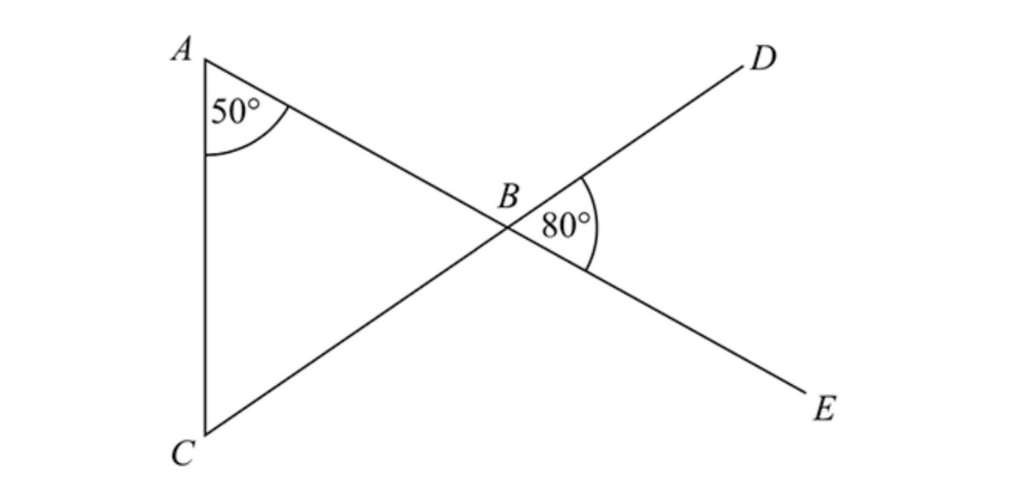
ABE and CBD are straight lines.
Show that triangle ABC is an isosceles triangle.
Give a reason for each stage of your working.
Model Answer:
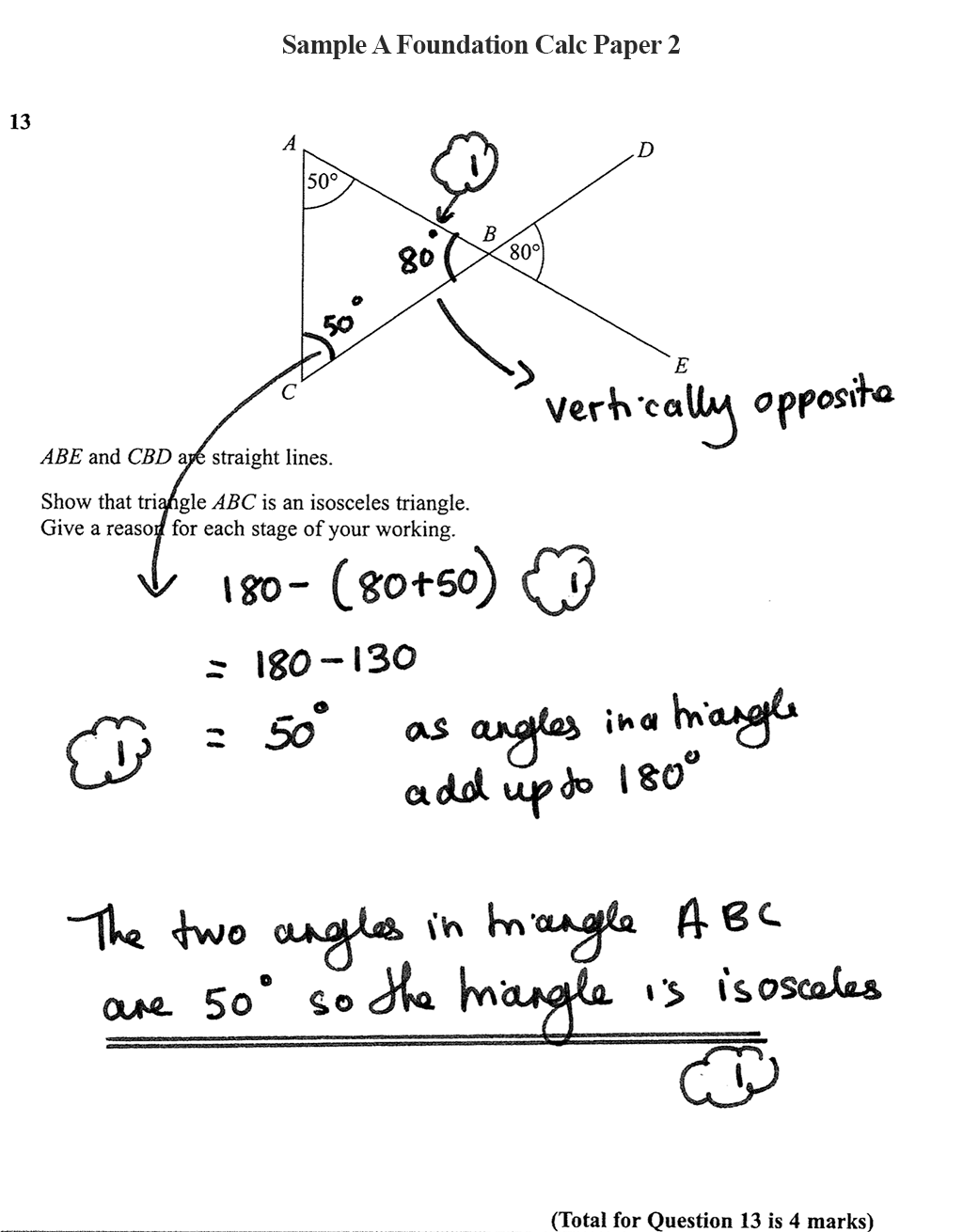
Properties of Polygons
A Polygon is a closed shape with straight sides. The sides can be of any length and the shape can be any size.
There are several types of polygons that you need to know for the GCSE Maths exam:
- Triangles: These are polygons with three sides.
- Quadrilaterals: These are polygons with four sides.
- Pentagons: These are polygons with five sides.
- Hexagons: These are polygons with six sides.
Each type of polygon has its own properties. For example, the sides of a triangle must add up to 180 degrees, but this is not true for other polygons.
Quadrilaterals
A Quadrilateral is a polygon with four sides. There are several types of quadrilaterals that you need to know for the GCSE Geometry exam:
- Rectangles: These have four right angles and opposite sides that are equal in length.
- Squares: These have four right angles and all sides are equal in length.
- Parallelograms: These have opposite sides that are parallel.
- Rhombuses: All sides equal in length.
We classify quadrilaterals according to their properties. For example, a rectangle is a type of parallelogram, but a square is not as all four sides are the same length.
Transformations
A Transformation is a way of changing the position, size or shape of an object. There are four types of transformations that you need to know for the GCSE Maths exam:
- Translation: This moves an object from one position to another.
- Rotation: This turns/rotates an object around a fixed point.
- Reflection: This creates a mirror image of an object.
- Enlargement: This changes the size of an object.
Transformations can be used to solve problems in Geometry. For example, if you know the coordinates of a shape before and after it has been translated, you can use this to find out how far it has been moved.
Circles
A Circle is a locus of points that are equidistant from a fixed point, called the centre. The distance from the centre to any point on the circle is radius.
There are several properties of circles that you need to know for the GCSE Geometry section in your Maths exam:
- The circumference of a circle is the distance around the outside edge. It is equal to 2πr, where r is the radius.
- The area is the amount of space inside a circle. It is equal to πr^2, where r is the radius.
- Angles at the centre of a circle are double the size of angles at the circumference.
Circles can be used to solve problems in GCSE Geometry. For example, if you know the circumference of a circle, you can use this to find its radius.
Vectors
A Vector is a mathematical object that has both magnitude and direction. We use vectors in Geometry to represent things like displacement, velocity and acceleration.
There are two types of vectors that you need to know for the GCSE Maths exam:
- Scalar vectors: These have magnitude but no direction.
- Directional vectors: These have magnitude and direction.
Vectors are used to solve problems in Geometry. For example, if you know the displacement of an object, you can use this to find its velocity or acceleration.
3D Shapes
3D Shapes are objects that have three dimensions: length, width and height. They are different from 2D shapes, which only have two dimensions: length and width.
There are several types of 3D shapes that you need to know for the GCSE Geometry exam:
- Cuboids: These have six faces that are all rectangles and are all at right angles to each other.
- Triangular Prisms: These have six faces that consist of 2 triangles and 3 rectangles.
- Pyramids: These have a triangular base and three or more triangular faces.
- Cylinders: These have two circular faces and one curved face.
3D shapes can be classified according to their properties. For example, a cube is a type of cuboid, but a rectangular prism is not.
Example 3D Shapes Question
Shape S is one quarter of a solid sphere, centre O.
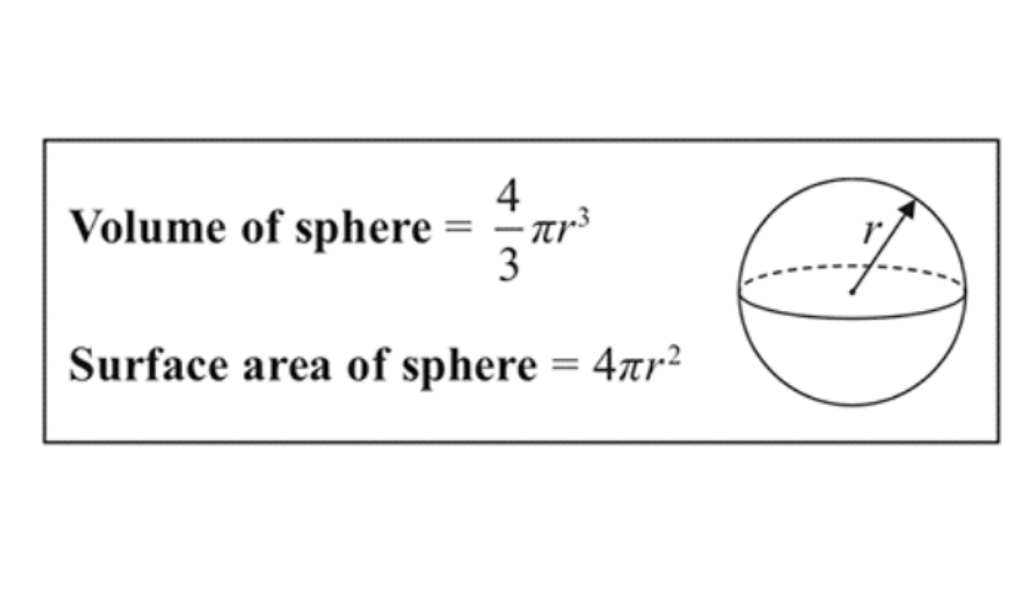
The volume of S is 576π cm³
Find the surface area of S.
Give your answer correct to 3 significant figures.
You must show your working.
Model Answer:
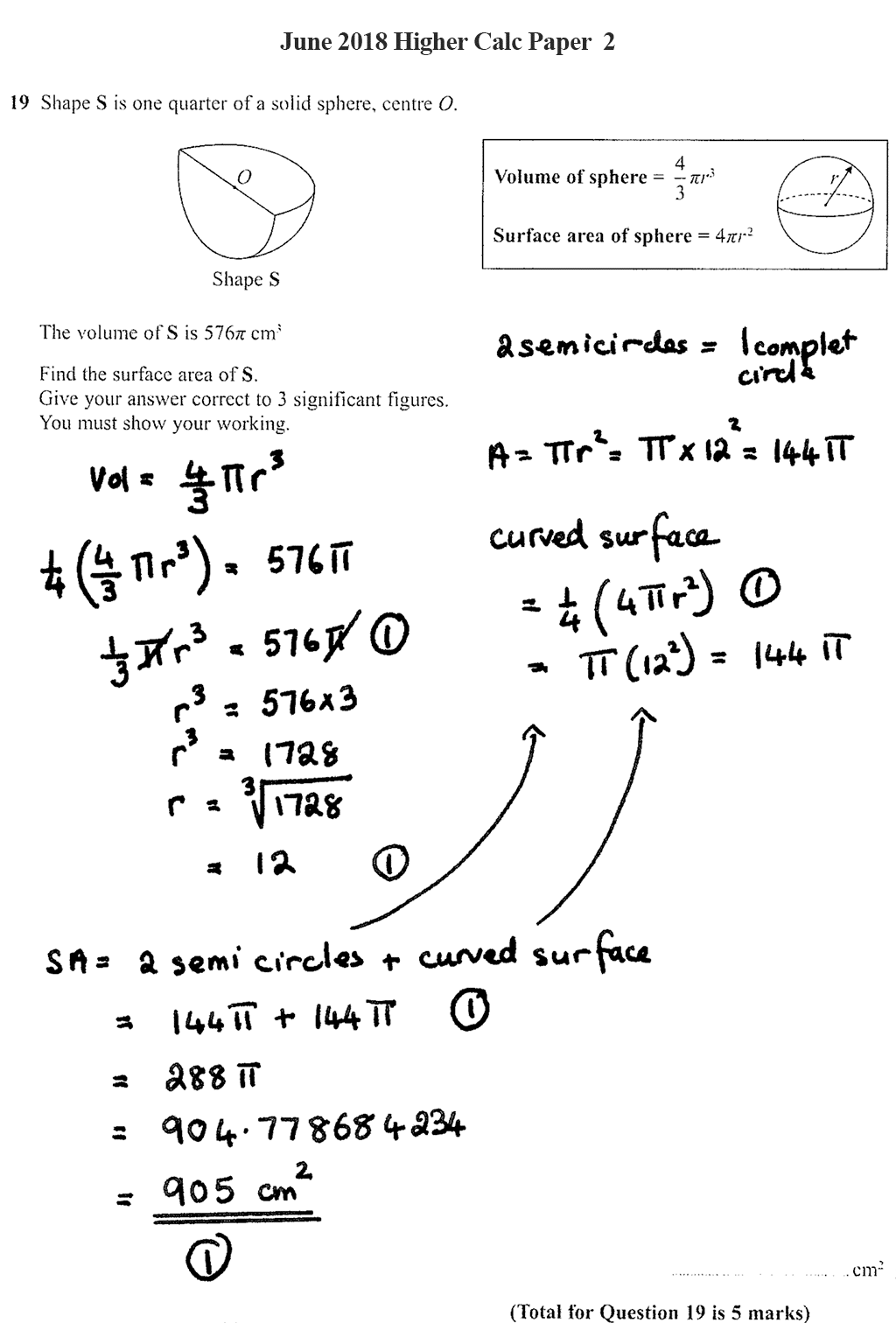
A brief overview of the GCSE Maths exam
The GCSE Maths exam, for all learners, totals to 4½ hours and covers a range of topics, including algebra, Geometry and statistics. The exam is in three parts and for each paper you have 1½ hours to complete.
Paper 1: Written paper, calculator permitted, 100 marks
Paper 2: Written paper, calculator not permitted, 100 marks
Paper 3: Written paper, calculator permitted, 100 marks
The GCSE Geometry section of the exam will test your knowledge of shapes, angles and constructions. You will need to be able to use a protractor to measure angles, and you will also need to know how to construct simple shapes using a straight-edge and compass.
The exam will also test your knowledge of basic statistics, including mean, median and mode. You will need to be able to interpret data from graphs and tables, and you will also need to know how to calculate basic probabilities.
Make sure you revise all of the topics listed above and try to do as many practice questions as you can. This will help you to familiarise yourself with the types of questions that come up in the exam.
Key points for revision
There are a few key things that you can do in order to revise for the GCSE Geometry portion of your exams. First, make sure that you are familiar with all of the concepts that will come up in the exam. This includes understanding how to construct shapes, identify angles and polygons, and calculate areas and perimeters. You should also be familiar with the different types of vectors and how they are used in Geometry.
Secondly, practice plenty of questions and exercises. The best way to test your knowledge is to try some real-world problems that mimic the types of questions you will see in the exam. There are plenty of resources available online, such as SchoolOnline or you can ask your teacher for practice exercises.
Finally, don’t forget to review the basics. Sometimes the simplest things can trip you up in an exam situation, so make sure you know all of the formulas and definitions by heart.
Be sure to:
- Use revision cards to make notes on key topics and revise them regularly.
- Set aside chunks of each week to revise, even if it’s 30 minutes a couple of days a week.
- Complete practice questions so that you are familiar with the types of questions that will come up in the exam.
- Time yourself when you’re answering questions.
- Draw diagrams to help you visualise the concepts you are revising.
- Get your head around tricky concepts with valuable revision tools like SchoolOnline
Advice for success on the GCSE Maths exam
There are a number of things that you can do to ensure success in your GCSE Maths exam:
- Make sure that you understand the concepts that you will be tested on. This means doing plenty of revision and practising as many questions as possible.
- Do not leave your revision to the last minute. Start revising early so that you have plenty of time to cover all the topics.
- Get plenty of rest and relaxation in the days leading up to the exam. This will help you to focus and do your best on the day.
- Take your time during the exam and read each question carefully before attempting to answer it.
- If you have time when you finish, read back over the paper and double check your answer.
When it comes to the GCSE Maths exam, it is important to remember that practice makes perfect. If you have practised a lot of questions, you will be more familiar with the types of questions that will be asked in the exam and will be more likely to get a great mark.
It is also important to revise all of the key topics that will be covered in the exam. Make sure you understand everything from basic concepts to more complex topic areas. If you are unsure about anything, ask your teacher or a tutor for help.
Conclusion
Your GCSE Maths exams can be challenging, but with enough preparation and revision, you can achieve your best. Make sure to revise all of the key topics that will be covered in the exam, and practice as many questions as possible.
If you need help with GCSE Geometry, then sign up to SchoolOnline where our expert tutors will help you understand and solve even the hardest question.


